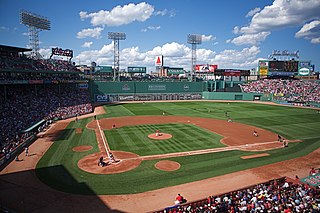The Boston School (also called the Stravinsky School) was a group of composers, most of them Jewish, from Boston, Massachusetts who were influenced by the neoclassicism of Igor Stravinsky: [1]

Boston is the capital and most populous city of the Commonwealth of Massachusetts in the United States. The city proper covers 48 square miles (124 km2) with an estimated population of 685,094 in 2017, making it also the most populous city in New England. Boston is the seat of Suffolk County as well, although the county government was disbanded on July 1, 1999. The city is the economic and cultural anchor of a substantially larger metropolitan area known as Greater Boston, a metropolitan statistical area (MSA) home to a census-estimated 4.8 million people in 2016 and ranking as the tenth-largest such area in the country. As a combined statistical area (CSA), this wider commuting region is home to some 8.2 million people, making it the sixth-largest in the United States.

Neoclassicism in music was a twentieth-century trend, particularly current in the interwar period, in which composers sought to return to aesthetic precepts associated with the broadly defined concept of "classicism", namely order, balance, clarity, economy, and emotional restraint. As such, neoclassicism was a reaction against the unrestrained emotionalism and perceived formlessness of late Romanticism, as well as a "call to order" after the experimental ferment of the first two decades of the twentieth century. The neoclassical impulse found its expression in such features as the use of pared-down performing forces, an emphasis on rhythm and on contrapuntal texture, an updated or expanded tonal harmony, and a concentration on absolute music as opposed to Romantic program music.

Igor Fyodorovich Stravinsky was a Russian-born composer, pianist, and conductor. He is widely considered one of the most important and influential composers of the 20th century.
- Arthur Berger [1] [2] [3] [4]
- Irving Fine [1] [2] [3] [4]
- Lukas Foss [1] [2] [3] [4]
- Alexei Haieff [2] [4]
- Harold Shapero [1] [2] [3] [4]
- Claudio Spies [2]
- Leonard Bernstein [3]
- Ingolf Dahl [2]
- John Lessard [2] [4]
- Louise Talma [5]
Irving Gifford Fine was an American composer. Fine's work assimilated neoclassical, romantic, and serial elements. Composer Virgil Thomson described Fine's "unusual melodic grace" while Aaron Copland noted the "elegance, style, finish and...convincing continuity" of Fine's music.

Lukas Foss was a German-American composer, pianist, and conductor.
Alexei Vasilievich Haieff was an American composer of orchestral and choral works. He is known for following Stravinsky's neoclassicism, observing an austere economy of means, and achieving modernistic effects by a display of rhythmic agitation, often with jazzy undertones.
Many of them studied with Nadia Boulanger. [2] Irving Fine described the music of Stravinsky and his followers as "diatonic and tonal or quasi-modal", pandiatonic, and concerned with chord spacing and rhythm. [2]

Juliette Nadia Boulanger was a French composer, conductor, and teacher. She is notable for having taught many of the leading composers and musicians of the 20th century. She also performed occasionally as a pianist and organist.

Rhythm generally means a "movement marked by the regulated succession of strong and weak elements, or of opposite or different conditions". This general meaning of regular recurrence or pattern in time can apply to a wide variety of cyclical natural phenomena having a periodicity or frequency of anything from microseconds to several seconds ; to several minutes or hours, or, at the most extreme, even over many years.


